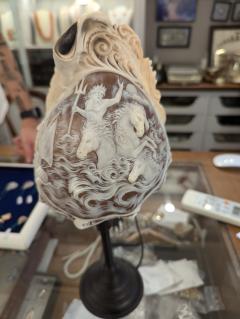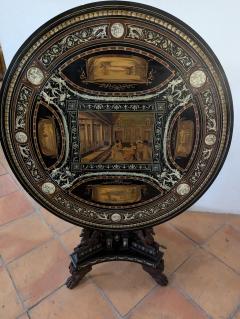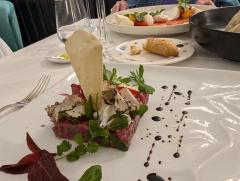 On Monday June 3rd, we explored Sorrento. Actually, we had three full days to explore Sorrento and its surroundings, including the Amalfi Coast and the storied isle of Capri. Naples is just across the bay, but we had another day planned for that when we left Naples. Until then, this was a chance to relax, explore, catch up on this Trip Record, Duolingo, and Facebook posts, and to make a deep dive into the traditional crafts and cuisine of Sorrento. For today's post I will focus on some of the traditional crafts of this area that have endured for generations and are still practiced today, and I will finish with some notes about the region.
On Monday June 3rd, we explored Sorrento. Actually, we had three full days to explore Sorrento and its surroundings, including the Amalfi Coast and the storied isle of Capri. Naples is just across the bay, but we had another day planned for that when we left Naples. Until then, this was a chance to relax, explore, catch up on this Trip Record, Duolingo, and Facebook posts, and to make a deep dive into the traditional crafts and cuisine of Sorrento. For today's post I will focus on some of the traditional crafts of this area that have endured for generations and are still practiced today, and I will finish with some notes about the region.
 For us, the most wonderful traditional craft of Sorrento and the area around the Bay of Naples is the cameo jewelry that has been made here since Roman times. A cameo is an image carved from and into a piece of shell, first cutting away the rough exterior to expose the internal layers, and then carving a bas-relief image in the upper white layer and clearing the background down to the base layer of pink or brown, depending upon the type of shell used.
For us, the most wonderful traditional craft of Sorrento and the area around the Bay of Naples is the cameo jewelry that has been made here since Roman times. A cameo is an image carved from and into a piece of shell, first cutting away the rough exterior to expose the internal layers, and then carving a bas-relief image in the upper white layer and clearing the background down to the base layer of pink or brown, depending upon the type of shell used.
Almost all of the cameo jewelry that you see in the United States is the traditional profile of a lady's head in a round ring, pendant, or earrings. Many of these are mass-produced in factories in Torre del Greco, a noisy and unlovely suburb of Naples. In Sorrento, the Bimonte family continues the tradition of hand-carved cameo jewelry on objets d'art. Here is a poodle cameo that Lorna had to add to her collection of Bimonte cameos that she has been collecting since our first lucky visit in 2015.
 After all that time and investment, on this trip I decided that I should have an example of this ancient craft for myself. This was our fourth visit to Sorrento and I had seen many fine pieces in the Bimonte shop, but it wasn't until this visit that I saw this magnificent lamp depicting Neptune in his chariot pulled by hippocampi, surrounded by stormy seas. It's carved from an entire shell; it's bigger than my hand. This will be a proud addition to my office, and a marvelous souvenir of our visits to Sorrento!
After all that time and investment, on this trip I decided that I should have an example of this ancient craft for myself. This was our fourth visit to Sorrento and I had seen many fine pieces in the Bimonte shop, but it wasn't until this visit that I saw this magnificent lamp depicting Neptune in his chariot pulled by hippocampi, surrounded by stormy seas. It's carved from an entire shell; it's bigger than my hand. This will be a proud addition to my office, and a marvelous souvenir of our visits to Sorrento!
Of course, I saw many other fine things during my peregrination through the crowded streets and alleys of the extensive shopping district. Lorna calls it a shopper's paradise and from the number of happy shoppers that I saw I think she's right. There are leather goods, clothing, limoncello, jewelry, handbags and shoes, more limoncello, souvenirs both cheap and expensive, and many gelaterias and full restaurants where you can take a break before plunging into another round of shopping.
 Another classic traditional craft of Sorrento is beautiful intarsia work: complex designs of inlaid wood. Some are geometric designs, others more lifelike images, and commonly there are lifelike images with geometric borders. These are designed and cut by master craftsmen using different varieties of wood, sometimes scored with parallel lines for a shading effect, sometimes the wood is dyed.
Another classic traditional craft of Sorrento is beautiful intarsia work: complex designs of inlaid wood. Some are geometric designs, others more lifelike images, and commonly there are lifelike images with geometric borders. These are designed and cut by master craftsmen using different varieties of wood, sometimes scored with parallel lines for a shading effect, sometimes the wood is dyed.
When the craftsman has created the first work, the components of his original were "mass-produced" using an assortment of ingenious tools from the eighteenth, nineteenth, and early twentieth centuries, now collected and on display at the Museo Bottega della Tarsia Lignea. There's also a museum shop where you can buy books about intarsia and even modern examples of this old art form. I spent over an hour exploring the museum, which is on several floors, and then chatting with the friendly proprietor. Intarsia souvenirs are still readily available, although I am sure that the machinery is updated!
 Eventually we reunited at the hotel before going next door for an incredible (and expensive) dinner at Ristorante Museo Caruso. The great tenor Enrico Caruso (1873-1921) was from Naples. He loved Sorrento and visited often. The owner of the restaurant has a large collection of Caruso memorabilia, much of which is displayed on the walls, and the great tenor's recordings play softly in the background. I had to come here!
Eventually we reunited at the hotel before going next door for an incredible (and expensive) dinner at Ristorante Museo Caruso. The great tenor Enrico Caruso (1873-1921) was from Naples. He loved Sorrento and visited often. The owner of the restaurant has a large collection of Caruso memorabilia, much of which is displayed on the walls, and the great tenor's recordings play softly in the background. I had to come here!
Our dinner was excellent. We had:
 A little prosecco on the house to welcome us, and then I ordered a bottle of the local Scorzagalline Fonzone Taurasi Riserva 2016. Taurasi is a big red from Campania made with the local Aglianico grape. If you like the Barolos and Brunellos of Piedmont and Tuscany, you should look for a good Taurasi.
A little prosecco on the house to welcome us, and then I ordered a bottle of the local Scorzagalline Fonzone Taurasi Riserva 2016. Taurasi is a big red from Campania made with the local Aglianico grape. If you like the Barolos and Brunellos of Piedmont and Tuscany, you should look for a good Taurasi.- An Insalata Caprese, the enduring culinary contribution of neighboring Capri. It was quite beautiful!
- Battuta Fassona, beef tartare made with beef from the highly regarded Piemontese Fassona cattle, served with shaved white alba truffle. This was very expensive, and worth every penny!
 Fiore di Zucca cacio e pepe, squash blossoms stuffed with a cheese and black pepper mixture and deep fried. You see the Fiore di Zucca a lot in Italy, but it's very difficult to get them in the US, even in jars or frozen.
Fiore di Zucca cacio e pepe, squash blossoms stuffed with a cheese and black pepper mixture and deep fried. You see the Fiore di Zucca a lot in Italy, but it's very difficult to get them in the US, even in jars or frozen.- I had Gamberoni Kataifi, the purple shrimp of Sicily that I had first seen in Gallipoli, wrapped up in kataifi (shredded phyllo pastry) so they looked like little tornadoes.
- Lorna had Ravioli Cavale, plump ravioli filled with chopped eggplant and served with a cherry-tomato sauce and whole semi-dried cherry tomatoes.
 Melissa had the Sorrentine classic Spaghetti Nerano, spaghetti with chopped fried zucchini. We learned about this dish on our last visit; I had read about it and Christian Bimonte told us where to get a good classic dish of it. Melissa especially loved it, and since then I have made Spaghetti alla Nerano for friends at home, I'll post the recipe soon.
Melissa had the Sorrentine classic Spaghetti Nerano, spaghetti with chopped fried zucchini. We learned about this dish on our last visit; I had read about it and Christian Bimonte told us where to get a good classic dish of it. Melissa especially loved it, and since then I have made Spaghetti alla Nerano for friends at home, I'll post the recipe soon.- Nuvola was a house special coffee–chocolate “cloud” dessert, as light and airy as its name suggests.
- I finished with a bit of Amaro Lucano, an Amaro made with southern herbs. Most amari are from the north, flavored with northern and Alpine herbs, so this was part of my locavore adventure.
It was quite a feast, but fortunately the restaurant is right next to the hotel so it was just a short stagger back to our beds!
